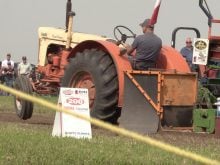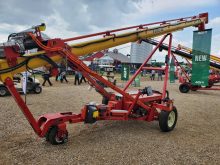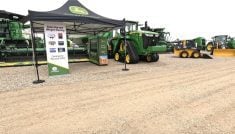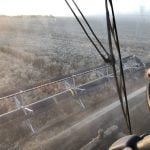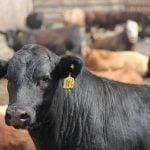Mother bins ease harvest bottlenecks, saving weeks of time and reducing manpower and equipment requirements
Even among the other agricultural behemoths on display at Ag in Motion near Langham, Sask., mother bins stand out, dwarfing the super B trucks they’re designed to service.
A mother bin is a grain tank on wheels, ranging in capacity from 4,000 to 8,250 bushels, depending on model and manufacturer. It is designed to address two pinch points at harvest: talent and time.
Crystal Kopecky, director of sales for Walkabout Mother Bins out of Jamestown, North Dakota, says farmers are using ever-larger combines to harvest higher yields, but what hasn’t changed is how grain is moved off the fields. The combine offloads to a grain cart, which then loads a super-B.
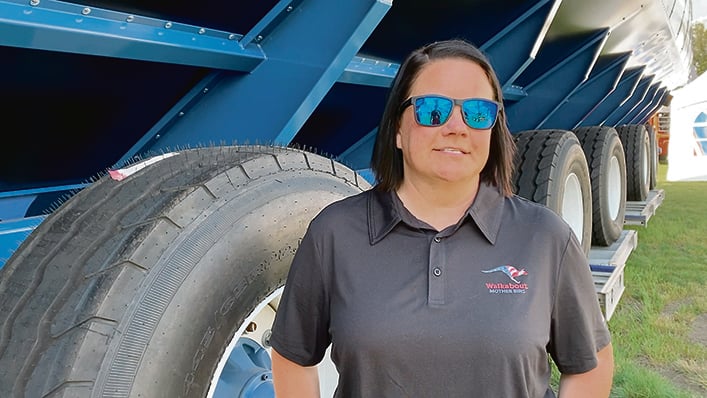
If that truck is delayed getting to the bins and back, the whole operation comes to a halt once the combine and cart are full. And that is assuming the super-B driver has started their shift.
Read Also

Trump’s tariffs take their toll on U.S. producers
U.S. farmers say Trump’s tariffs have been devastating for growers in that country.
“You’ve lost a lot of daylight hours waiting on your help to arrive,” Kopecky says. “With a mother bin, it allows the combine to start running at any time, whether the trucks are there or not, and at least get four to 6,000 bushels behind them for them to be able to haul away when that driver comes.”
Getting trucks quickly on their way is handled by the mother bin’s 22-inch auger, which can move up to 900 bushels per minute, Kopecky says. The bin itself has enough capacity to load a whole B-train in one shot.
The bin section on this particular 6,000-bushel model is 15 feet wide, 13.5 feet tall and 60 feet long, with another 10 feet of hitch assembly. The whole thing sits on a massive frame centred on continuous steel frame rails on top of seven axles.
Kopecky says Walkabout has so far sold more than 85 of its mother bins across North America from Louisiana to the Pacific Northwest and into Canada.
“It’s very strong, and that’s what allows us to keep this bin on our tires,” Kopecky says. “You know, a lot of big bins like this sit down on their frame. Again, what makes us unique is that we can be moved while partially loaded.”
If Mother Nature decides to pull out a quick thunderstorm with several thousand bushels of exposed grain in the mother bin, a solar-charged, battery-driven electric tarp system can be deployed within minutes.
Kopecky is vague when discussing pricing, as she says Walkabout prefers to talk time savings and return on investment.
“This is one of the biggest things, aside from their combine, that they’ll buy and (we’ve) really got to drive home the concept because they don’t know any different,” she says. “Waiting is just something that they’ve always had to do, and now, with a mother bin, they don’t have to do that anymore.
“Dave, the owner of the company, says that the only people that don’t like the mother bin are truck drivers, because they don’t get a break.”
Mother bins are gaining popularity in North America after the idea was brought here from Australia, where they have been in use for decades. Walkabout’s logo, a kangaroo outline over an American flag, reflects these origins, but they are not the only game in town.
Mike Friesen, CEO with Elmer’s Manufacturing in Altona, Man., says they consciously took the traditional tack with their Hive mother bin. That is, its four transport wheels are mounted on single tandem axles.
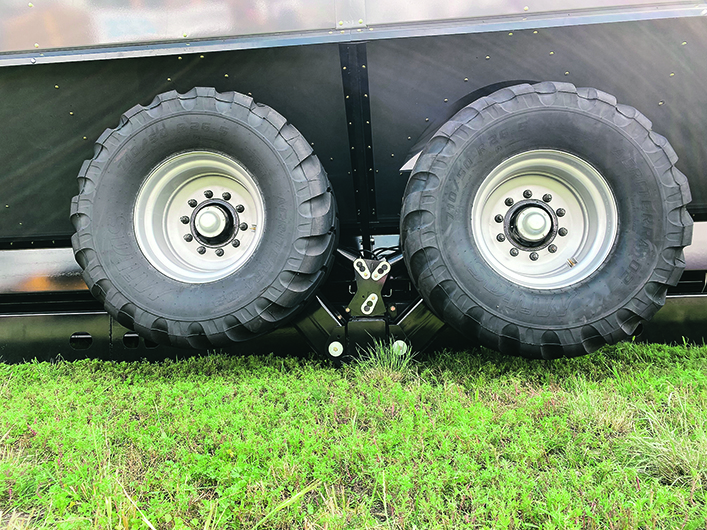
Hydraulics lower the frame of the Hive onto the ground, where it doesn’t move again until it’s nearly empty and time to move to the next field. It can be moved with up to 10 tons of product on board.
“We went this way because we were looking for the larger capacity and doing it with the frame on the ground makes that easier,” he says. “And then the second thing is, it does make our scaling a little more stable as well, too.”
The model on display at Ag in Motion is the company’s newest and smallest, with a capacity of 5,500 bushels. Its larger unit holds 8,250 bushels.
Friesen says the company got into the mother bin business as it saw farmers faced with problems in harvest logistics. That is, getting the crop efficiently off larger fields over distances that are growing with the size of farms. A solution was already in use Down Under.
“We do a lot of business in Australia, so they’ve been using this type of product for many years,” he says. “We’re seeing some of these conditions pop up in Western Canada that cause this to become a need and a way to resolve a bottleneck of getting crop from the field to its destination.”
Friesen also points to larger combines and better crop genetics leading to more tonnes per hour coming off the fields at harvest time. Adding to the bottleneck is a lack of drivers with Class 1 licences to drive trucks. On their own farm, they’ve addressed this with contract truckers, which increases the pressure to keep those trucks moving.
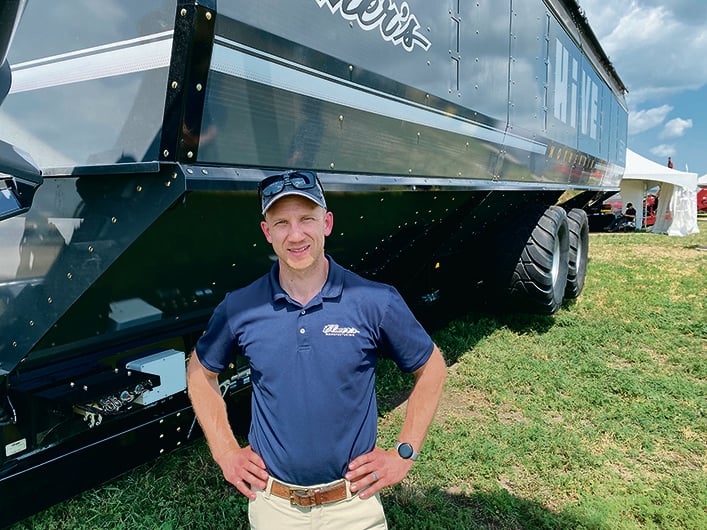
The mother bin also solves the grain cart capacity problem. For example, a full 2,500 bushel grain cart may have too much product for the truck or conversely not enough to fill an empty truck that just arrived.
“So here (with a mother bin), they can unload in all one go, and then the truck can come in and fill in one go and then that keeps both ends of the cycle going,” Friesen says.
Price point on the Hive mother bin runs from $330,000 to $460,000, depending on the model. While this is a significant expense, Friesen says a mother bin can fit both larger and smaller operations.
For instance, for a larger farm, it’s about increasing overall tons per hour. For a single operator, single machine operation, it allows the farmer to harvest without interruption while the weather holds. Then, when the dew comes down, they can switch to hauling.
This also applies to changing quality during the day. The Hive mother bin features a front and back compartment and a handling system that allows mixing. This means, for example, that wetter grain from the morning’s work can be blended with drier grain from the afternoon to load a consistent product for the elevator.
Friesen says the focus is to add and improve technology such as live weights, GPS and detailed load tracking to record what is coming off which field. Side and end windows allow operators to see how much grain is in the mother bin from the ground, while remote controls deploy functions such as auger and electric tarp system.
Vale Industries of Indian Head, Sask., is also a part of the Australian invasion of mother bins, although they are known as simply field bins in their shop.
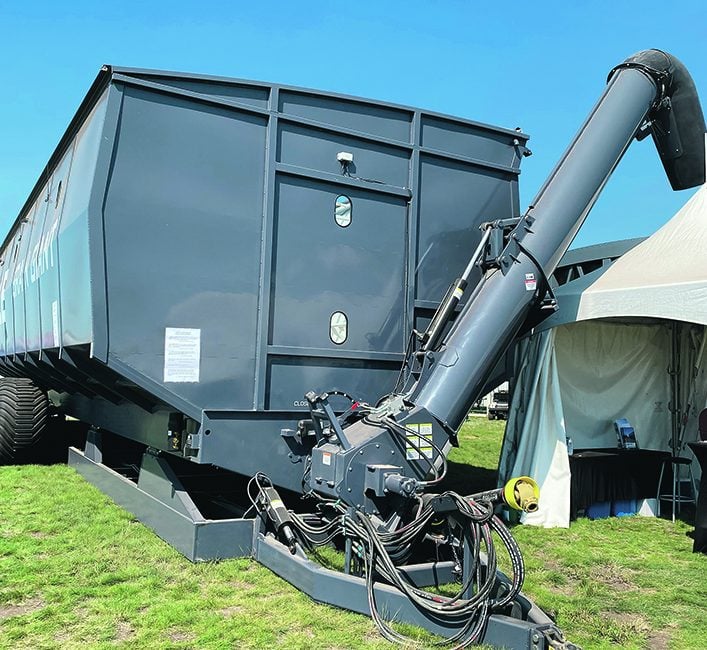
A previous owner observed the bins in use in Australia and brought their established 6,500 bushel Grain Giant design back to Canada starting in 2020.
“It’s catching on,” says Greg Gessner, senior technical sales manager with Vale. “I don’t have to explain it to the grass roots; they’ve caught on already. They have the idea, and kind of pencil it in with their equipment.”
The Grain Giant is also designed to run on four wheels during transport and lower itself to the ground once placed in the field. The company also touts reduced work force needs, fewer trucks needed, and enhanced safety as operators are less inclined to rush back to the field or storage yard.
It includes blending capabilities to ensure a consistent product, particularly when hauling directly to the grain terminal.
“It saves a week or two at harvest,” Gessner says. “It adds up. Combines are always 10 minutes here, 20 minutes there. It adds up.”
In a Vale testimonial video, Marwayne, Alta., farmer Garth George explains that the Grain Giant solves the problems of limited storage at his 6,000-acre farm as well as a growing contract trucking bill to get his crop to the elevator.
“When I saw this, it eliminated probably six or seven extra trucks down to my two personal trucks and when you load in eight minutes, it beats the 45 minutes that a semi was sitting here, not being used, with a driver not doing anything.”
Contact michael.robin@producer.com




